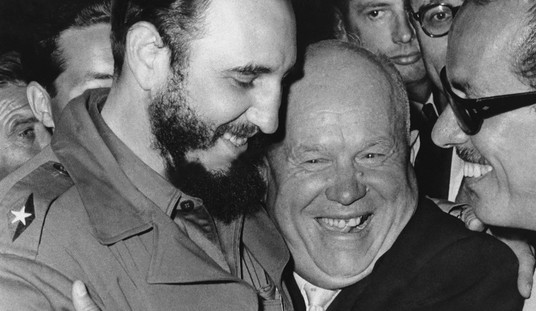Did Donald Trump get results in his Twitter tirade this afternoon aimed at three Democratic governors? This is almost certainly yet another application of the axiom that correlation does not necessarily indicate causation. As correlation does indicate an opportunity to capitalize politically, though, it should also be posited that correlation doesn’t necessarily not mean causation either, so YMMV.
Trump went after governors in Virginia, Michigan, and Minnesota over their shelter-in-place regimens, although Trump had another bone to pick with Ralph Northam in the Old Dominion:
https://twitter.com/realDonaldTrump/status/1251169987110330372
https://twitter.com/realDonaldTrump/status/1251169217531056130
https://twitter.com/realDonaldTrump/status/1251168994066944003
Not coincidentally, conservative groups planned demonstrations in each of these states against what they see as excessive shelter-in-place policies. In Virginia, the gun control law signed by Northam is worthy of criticism, and the arbitrary nature of Michigan’s policies are worthy of criticism and pushback, which we’ve covered fairly extensively here. It’s also where Gretchen Whitmer has tried to make herself into a leading anti-Trump voice. However, just how wise it is to stoke anger with calls to “liberate” states in this fashion in the middle of a destabilizing event like a pandemic is *ahem* debatable. Especially when it comes less than 24 hours after Trump just got done saying that re-opening decisions will be left to the governors and pledged support and assistance in meeting their goals.
As my pal and colleague Guy Benson noted at the time:
Yesterday: Good, responsible, sober-minded reopening plan rollout, with states afforded needed leeway and authority.
Today: https://t.co/QdPJw3zYU8
— Guy Benson (@guypbenson) April 17, 2020
Not only does this sound irresponsible, it demonstrates instability in leadership at a moment when people need as much calm, stability, and outward focus as possible. The more Trump makes this about himself, the less effective he becomes, and the more voters will fall back into their partisan divides.
But did he get results? In Minnesota, Gov. Tim Walz announced an end to a number of outdoor-venue restrictions, although with social-distancing requirements remaining in place:
Just in time for the last of the melting snow, Minnesota Gov. Tim Walz announced Friday he’ll allow golf courses in the state to open. Courses and driving ranges can open Saturday at 5 a.m.
The Governor’s new executive order, according to a news release, also “allows Minnesotans to engage in a range of activities, including golfing, boating, fishing, hunting, and hiking, as long as they follow new outdoor recreation guidelines. These guidelines include maintaining 6-foot social distancing, avoiding crowded areas, and staying close to home.”
Under the order, facilities that may reopen or remain open include bait shops, shooting ranges and game farms, public and private parks and trails, boating, marina services, dock installation and boat/off-highway vehicle sales (by appointment only).
All can open at 5 a.m. Saturday.
This follows a similar order from Wisconsin’ Tony Evers that opened golf courses yesterday, before Trump tweeted his “liberate” message. If anything prompted Walz into that action, it was probably Evers’ order, especially with Twin Cities golf courses so close to the Wisconsin competition:
Some of those courses Evers opened are in western Wisconsin just across the border from Minnesota, where courses had remained closed by Walz’ executive order that started March 17 and then became part of his stay-at-home order that now is set to expire May 4.
Ah, competition! It makes for much better business outcomes than edicts. The Star Tribune reports that the state’s golfing industry, which is considerable, and GOP state legislators had been pressuring Walz to consider this for some time, and that pressure went into overdrive after Evers’ action. Walz had already modified his order to allow for maintenance of outdoor venues to begin after the snow melted off (and then came back, and is now melted off again). It’s been on the table for a while, in other words.
It also follows some results of scientific study that indicate outdoor venues do not present much risk as transmission environments in this pandemic. This study comes from China, which has hardly been a reliable source on COVID-19 data, but given that it has few implications for Communist Party leadership, it’s worth a look:
Three hundred and eighteen outbreaks with three or more cases were identified, involving 1245 confirmed cases in 120 prefectural cities. We divided the venues in which the outbreaks occurred into six categories: homes, transport, food, entertainment, shopping, and miscellaneous. Among the identified outbreaks, 53.8% involved three cases, 26.4% involved four cases, and only 1.6% involved ten or more cases. Home outbreaks were the dominant category (254 of 318 outbreaks; 79.9%), followed by transport (108; 34.0%; note that many outbreaks involved more than one venue category). Most home outbreaks involved three to five cases. We identified only a single outbreak in an outdoor environment, which involved two cases. The first salient feature of the 318 identified outbreaks that involved three or more cases is that they all occurred in indoor environments. Although this finding was expected, its significance has not been well recognised by the community and by policy makers. Indoors is where our lives and work are in modern civilisation. The transmission of respiratory infections such as SARS-CoV-2 from the infected to the susceptible is an indoor phenomenon.
In other words, we might be making a mistake by keeping the focus on indoor economic activity without recognizing the much lower risk for outdoor venues. This makes sense anyway, as activities like golfing and landscaping are hardly characterized by close physical proximity to others. Viral load matters in transmission, and that will be more of a problem in an enclosed environment than out in the open — no matter what Gretchen Whitmer thinks. As long as people wear masks, don’t share equipment, and don’t share carts, physical distance should be relatively easy to maintain in these activities.
Trump’s tweet didn’t make much sense in another way; Walz was reluctant to issue his “shutdown” order in the first place, dithering over it for more than a week before finally pulling the trigger. It also wasn’t nearly as arbitrary or onerous as the protocol in Michigan, nor as harshly imposed as in other states. While conservatives here have chafed at it, it was really the extension of the order that prompted the protest here rather than the protocols themselves. And Walz’ extension almost exactly matches the White House’s own extension of their “Flatten the Curve” program too. Trump has lots of reasons to go after Northam and Whitmer, but the attack on Walz is strange indeed.
Anyway, Minnesotans can now look forward to more outdoor distractions from the COVID-19 nightmare, and hopefully a quicker economic rebound because of it. Trump can take credit for it if he likes, as correlation is pretty fungible, but it’s more likely the result of pressure from Republicans in the legislature and Evers’ move yesterday. Again, YMMV.








